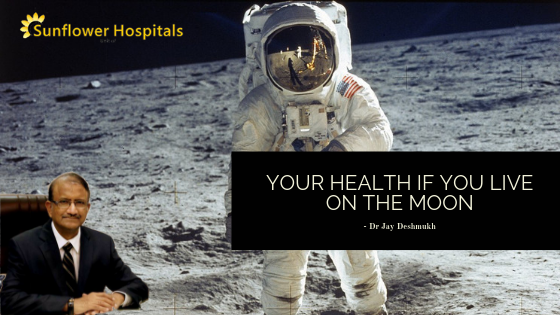Ever since Chandrayaan 2 had been launched, there has been a lot of speculation about how life would be on the moon. People have already decided to buy land and make housing societies and colonies. Do you plan to move into a flat on the moon? Well, that may be possible after a few years. What about your health problems if you move to your new address?
How many people have lived on the moon surface so far?
- Despite NASA’s successful Apollo landings, humans have very little time on the moon. In total,12 Apollo astronauts lived on the moon surface for roughly 10 days and travelled outside their lander for only 80 hours. In such a short time they merely caught a glimpse of the risks associated with survival there.
What were the obvious hazards?
- Besides the rocket flight, zero-gravity nausea and a risky landing, the moon itself can be dangerous. When astronauts walked on the moon, the dust clung to their spacesuits, scratched their visors, made their eyes water and their throats dry. It smelled like gun powder inside the lander.
What is the dust on the moon like?
- Lunar dust is composed of silica, is fine like a powder but cuts like glass. Lunar dust hay fever was experienced by Harrison Schmitt of Apollo 18. Mr Schmitt spent just 22 hours on the surface. A recent study indicated that prolonged exposure could lead to more serious effects, like bronchitis or cancer.
What about going for a walk on the moon?
- The moon ‘s wrinkled surface is more dangerous than the pits that you see on our roads particularly during earth’s monsoon. A moon is not a desert as most of you think. It is more like an ocean. It is very undulating like the sea swells. There is an intense contrast between light and dark, that can play tricks on your eyes. Do not forget to wear your special spectacles when you go for your morning walk on the moon. You have to walk like a baby elephant or like a 9-month pregnant woman, as our moon’s gravitational pull is very less as compared to your earth.
Is there any fear of moonquakes like your earthquakes?
- A recent study suggests that our lunar neighbour is tectonically active. The moonquakes are 5.5 times the magnitude of earthquakes. This may be bad news for those who want to live in skyscrapers on the moon. For the lunar earth, sorry the lunar ground may always be shaking.
How about sleep rhythm on the moon?
- Sleep may not be that easy without pills. Our body clocks on our Mother Earth are wound by light exposure. On earth, our day and night are in rhythm every 24 hours. In your new home on the moon, the same shift occurs once every 28 days.
What about the hazard of radiation?
- Anyone outside the earths protective atmosphere and magnetic field always receives a hefty dose of radiation. This is more than 200 times more than on earth. This is perhaps the biggest challenge. It is a stark reminder that you are no longer under the protective womb of the planet that has nurtured us.
What about the risks of cosmic rays on the moon?
- The cosmic rays on the moon can damage your DNA and can cause cancer. Long term effects of radiation can result in memory loss, anxiety, depression and impaired decision making. Though common on this planet, it appears to be more on your other planet.
The moon is an excellent destination for our scientific success and research. We are always proud of our scientific community. However, do not be in a hurry to have your house there. It may not be your next holiday destination so soon. Till then consider conserving our own ecosystem. Prevent warming of earth and plant as many trees as you can. Do away with plastic. You may, however, plan your honeymoon but not on the moon in the very near future.
Author: Dr Jay Deshmukh
Dr Jay Deshmukh is Chief Physician and Director, Sunflower Hospital, Nagpur Honorary Physician to Honorable Governor of Maharashtra and PondicherryCentral. Dr Jay Deshmukh is an M.B.B.S., M.C.P.S., F.C.P.S., M.N.A.M.S., MD From Internal Medicine – Bombay and New Delhi.


